Looking for tips on boosting your eCommerce SEO?
Ecommerce businesses face the constant challenge of standing out and driving traffic to their online stores. However, with more eCommerce businesses popping up daily, the importance of effective eCommerce SEO (Search Engine Optimization) cannot be overstated.
In this comprehensive guide, we’ll equip you with the essential strategies and tactics to optimize your eCommerce website for search engine success in 2024 and beyond.
What is eCommerce SEO?
eCommerce SEO (Search Engine Optimization) is the practice of optimizing your online store to rank higher in search engine results pages (SERPs) for relevant keywords. This helps drive organic traffic (free visitors from search engines) to your website, which can significantly increase sales and brand awareness.
The Importance of eCommerce SEO
Investing time, effort, and resources into crafting and running eCommerce SEO campaigns is crucial to your business’s success. Here are some reasons why:
- Attract targeted traffic: Proper eCommerce SEO ensures that your products and services are found by consumers actively searching for them using relevant keywords, leading to more qualified leads.
- Enhance user experience (UX): Well-optimized eCommerce sites provide a seamless and intuitive user experience, improving sales, customer satisfaction, and loyalty.
- Outperform competitors: Effective eCommerce SEO can give you a competitive edge, helping you outrank and outperform your rivals in search engine results.
- Drive sustainable growth: Organic search engine traffic is a reliable and cost-effective source of leads, contributing to long-term business growth.
- Improved brand awareness: High search rankings enhance your brand credibility and establish you as an authority in your niche. This, plus increased visibility, helps boost your brand visibility.
As you can see, eCommerce SEO plays a huge role in helping your business grow and thrive. That’s why you should implement SEO best practices that will catapult your business to the top of the SERPs.
10 Tips for Impactful eCommerce SEO
Now that you know what eCommerce SEO is and its importance, let’s quickly run through some tips to help you get it right.
1. Use the Right WooCommere SEO Tool
One of the first steps to impactful eCommerce SEO is to ensure you’re using the right SEO tool. And for WordPress users, there’s no better tool than All In One SEO (AIOSEO).
AIOSEO is a powerful yet easy-to-use SEO plugin that boasts 3+ million active installs. Millions of eCommerce merchants, marketers, and bloggers use AIOSEO to help them boost their search engine rankings and drive qualified traffic to their sites. That’s because the plugin has many powerful features and modules designed to help you properly configure your SEO settings.
Regarding eCommerce SEO, some of the most useful features include:
WooCommerce SEO
WooCommerce is one of the most popular platforms for building eCommerce stores. AIOSEO has a powerful module designed specifically for sites built on WooCommerce.
If you want to build an eCommerce business but find WooCommerce overkill, check out our list of the top WooCommerce alternatives.
Next-gen Schema Generator
AIOSEO’s no-code schema generator enables you to generate and output any schema markup on your site. For eCommerce brands, some types of schema markup you can benefit from include:
Implementing schema markup is agreat way to boost your chances og getting featured snippets and rich snippets on search engines.
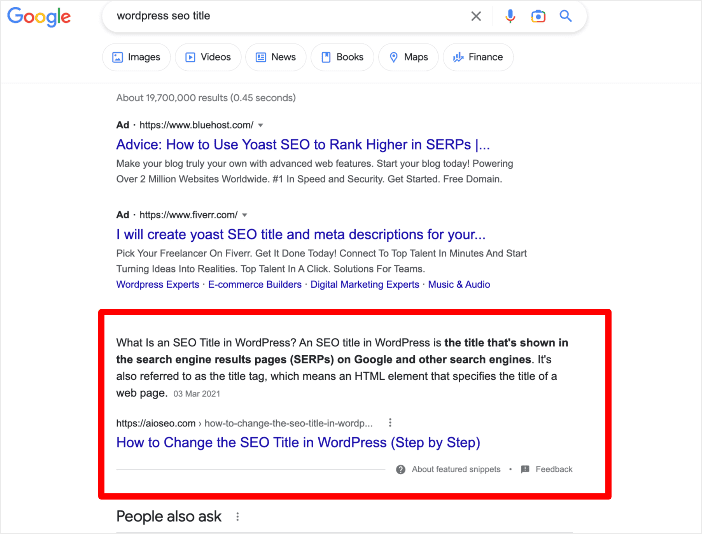
These are a great way to capture the lion’s share of traffic on page 1 of SERPs.
Link Assistant
Internal links play a huge role in improving the crawling and indexing of your site. They also help boost your search rankings. That’s why building internal links on your eCommerce site is crucial.
And AIOSEO’s Link Assistant makes that super easy to do.
Link Assistant is a powerful tool that crawls your site and gives a report on all the links on your site.
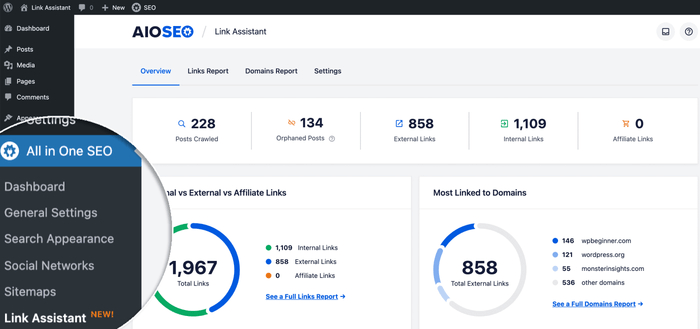
It also gives you a Links Report that shows you internal linking suggestions and your site’s orphan pages.
With Link Assistant, you can build a robust internal linking structure that can help your site and product pages rank high on SERPs.
Other examples of features that can help you rank your content and products include:
- Author SEO: This module helps you demonstrate Google’s E-E-A-T content quality standards.
- Cornerstone Content: Easily build topic clusters and enhance your topical authority and semantic SEO strategy.
- Search Statistics: This powerful Google Search Console integration lets you track your keyword rankings and see important SEO metrics with 1-click, and more.
- SEO Revisions: Track any changes you make to your site and see their impact on your SEO. Plus, you get to see on a timeline how Google updates affect your site.
- Advanced Robots.txt Generator: Easily generate and customize your robots.txt file for better crawling and indexing.
- Redirection Manager: Helps you manage redirects and eliminate 404 errors, making it easier for search engines to crawl and index your site.
- And more.
AIOSEO also has many other features to help you boost your local SEO, on-page SEO, and technical SEO.
For step-by-step instructions on how to install AIOSEO, check our detailed installation guide.
2. Write SEO-friendly Product Descriptions
Once you’ve installed your WordPress SEO plugin, your next port of call is to master eCommerce SEO. This, for the most part, means getting your product page SEO right.
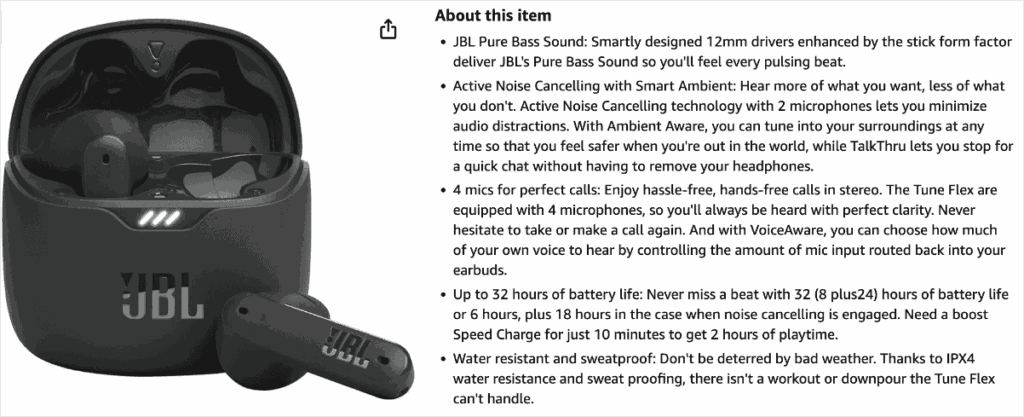
Some product page SEO basics you should start with include:
Proper Keyword Research
Ensure you research the right keywords your customers use when searching for your products. Once you have them, include them in the:
- Metadata (URL, title tags, and meta description)
- Image ALT text
- Product descriptions
You should also try to include your keywords in any place you use text on your product pages. However, make sure your keyword usage is natural. Otherwise, you may be penalized for keyword stuffing. Plus, excessive use of keywords can be off-putting to visitors, resulting in high bounce rates.
Quality Copy
Besides proper keyword research and usage, your eCommerce SEO also hinges on good copywriting. Make sure all your copy is clear, concise, and helpful. This is especially true after Google’s Helpful Content Update (HCU). Both users and search engines favor high-quality content that meets search intent. This means you should avoid:
- Spammy and clickbaity product descriptions
- Keyword stuffing
- Thin content
Instead, ensure that every word on your eCommerce site adds value to your store’s customer experience (CX).
3. Leverage AI to Boost Content Production
Explore AI tools like writing assistants to streamline content creation on your eCommerce store. You can use them to speed up so many content creation tasks, such as:
- Product descriptions
- Blog posts
- Video content
- Marketing copy (like emails, social media, etc.)
Once you’ve created your content, you’ll also need to add metadata as part of your on-page SEO strategy. Again, AI can help, this time, in the form of AIOSEO’s AI Title/Description generator. This is a powerful tool that automatically generates SEO titles and meta descriptions that are optimized for better conversions.
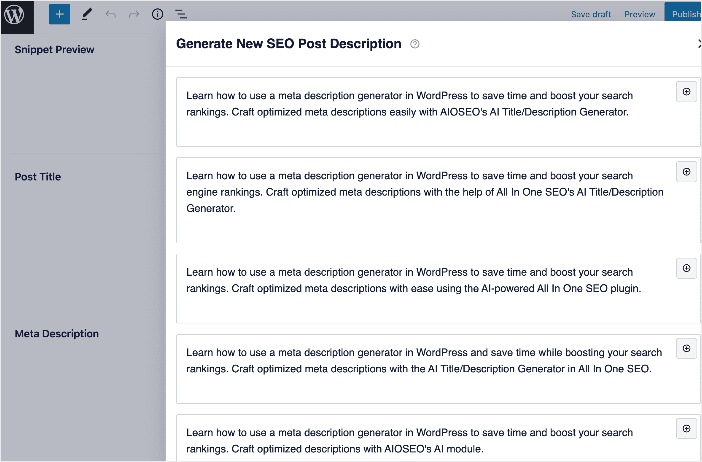
The tool crawls your content and generates meta descriptions and SEO titles based on your content.
Besides using AI writing tools, you can also leverage content marketing tools. These can help you with the whole content cycle, from ideation to promotion. A great example is SEOBoost.
4. Follow Image SEO Best Practices
Images play a huge role in creating impactful eCommerce pages. After all, your customers need to see the product they’re shopping for. That’s why you should pay close attention to your image SEO. A few tips for image optimization include:
- Using high-quality images
- Adding SEO-friendly ALT text and image captions
- Using descriptive image file names
- Creating image sitemaps
Images aren’t just an aesthetic addition to help display your products. They also increase your discoverability on search engines as you can rank in image search. Paying attention to how you use them, particularly the SEO implications, is crucial to your success.
For step-by-step instructions, check out our guide on boosting your image SEO.
5. Optimize Page Titles [AI-powered Cheat Code #1]
Title tags and meta descriptions are crucial elements of SEO. This is because they’re the first elements of your product page that users interact with on SERPs. Plus, search engines consider them when trying to understand what your pages are about. Here’s an example of how they would look on SERPs:
![The Ultimate Guide to Ecommerce SEO [2024 Edition] 1 Example of search snippet showing SEO title and meta description.](https://aioseo.com/wp-content/uploads/2024/10/ecommerce-seo-seo-title-example.png)
To optimize your SEO title tags and meta descriptions, some attributes to include are:
- Your keyword
- The name of the product
- The brand name
- The model number
Including all this information in your SEO title tags and meta descriptions will help users determine whether your product is what they’re looking for and help your pages rank well on search engines.
Check out our article on Merchant Center Listing schema for more details.
And because eCommerce sites have a lot of pages, this can be a mammoth task. This is where an AI cheat code comes in handy. And AIOSEO gives you just that in the form of the AI Title/Description Generator. This powerful tool automatically generates SEO title tags and meta descriptions from your content and gives you 5 suggestions to choose from.

AIOSEO’s AI Title Description Generator does all this with the single click of a button. The best part is that the titles and descriptions are SEO-friendly!
6. Use Product Review Schema
One of the best ways to boost credibility and authority is to display reviews and testimonials from satisfied customers. This also boosts your Google E-E-A-T score and encourages new visitors to trust your product offerings.
Reviews are a powerful form of social proof and can boost conversions.

This is why reviews are important for your eCommerce SEO strategy.
Ask your customers for reviews and display them on your homepage, product pages, and anywhere else relevant. Make sure to add product review schema to help search engines understand that your pages contain reviews.
To add reviews on your site, use AIOSEO’s next-gen Schema Generator.

This powerful tool makes it easy to add any type of schema to your site. You can even use it to generate custom schema.
For more on this particular topic, check out our tutorial on adding product review schema in WordPress for step-by-step instructions.
7. Use the Right URL Structure
Your URLs are an essential element of your technical SEO. That’s why you must ensure they’re SEO-friendly. SEO-friendly URLs contain keywords so that they can clearly explain your page’s content. This makes your URLs easy for humans and search engines to read. Here’s an example of an optimized URL:
http://www.example.com/wordpress-seo-tips/http://www.example.com/wordpress-seo-tips/
This URL is short, descriptive, and easy to read. Search engines and online users can easily tell what the web page is about
On the other hand, unoptimized URLs are long and usually don’t make sense. They usually include numbers, letters, and special characters. Check out the example below:
https://www.example.com/?p=10467X&UKEwiv9vuz1tXsAhUThis type of URL can hurt your SEO and conversions. That’s why you should take a few moments to optimize your URLs. For tips on doing so, check out our guide on the best WordPress permalink structure.
8. Enable Breadcrumb Navigation
Your site visitors may visit many pages as they explore your products. Make it easy for them to navigate back and forth between the pages they passed through and where they currently are.
You can do this by implementing breadcrumbs.
Breadcrumbs are navigational links that make it easy for users to explore your website. As the name suggests, they’re like a trail you leave, so you can use it to double back to where you’re coming from.
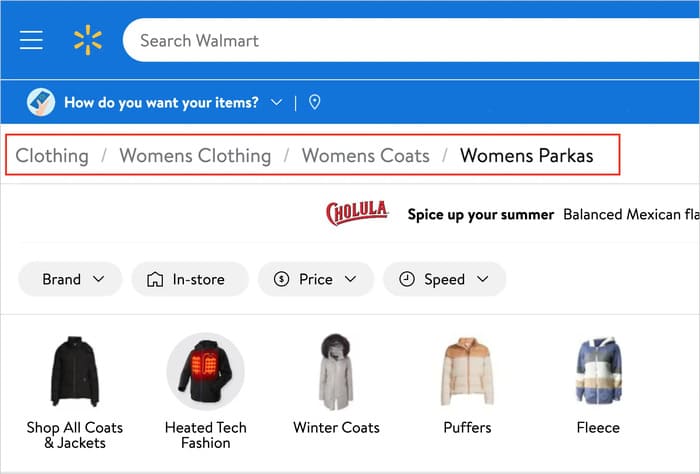
Because breadcrumbs are clickable, users can use them to quickly backtrack to previously visited pages. Breadcrumbs also have many SEO and user experience (UX) benefits, with some of the main ones being:
- Increased conversion rates: This is because breadcrumbs make it easier for users to explore a site, resulting in higher engagement and lower bounce rates.
- Improved search visibility: Breadcrumb schema markup can help a web page appear in search results for a breadcrumb term.
- Improved crawling: Because breadcrumbs add internal links, this can help search bots better crawl and understand your site structure.
As you can see, implementing breadcrumbs improves your site’s navigation, resulting in better rankings and a more positive UX.
9. Don’t Forget Conversion Rate Optimization [AI-powered Cheat Code #2]
Another important aspect of eCommerce SEO is conversion rate optimization (CRO). This is the art and science of encouraging more conversions on your site. This is where my second AI-powered cheat code comes into play, from a lead generation tool called OptinMonster.

OptinMonster has an AI-powered feature called Smart Optimization. This is an AI-driven text suggestion tool you can use to generate powerful text copy in your lead generation campaigns. For example, you can use it to:
- Create or improve your campaign headline or text
- Optimize your campaign text
- Get optimized suggestions for each text element
These features make creating pop up campaigns easier, faster, and more efficient. Plus, your pop ups will become more appealing to your site visitors. The result is an uptick in your conversion rates, resulting in more return visitors, and, of course, sales.
10. Boost Engagement (And Sales) With Push Notifications
Got some new products you think your customers will like?
Don’t wait for them to discover them by chance. Instead, tell them about it!
One of the best ways to do that is to use push notifications.
A push notification is a message from your site that pops up in a user’s browser or device. Push notification tools like PushEngage make this possible. And you don’t even have to touch a single line of code.
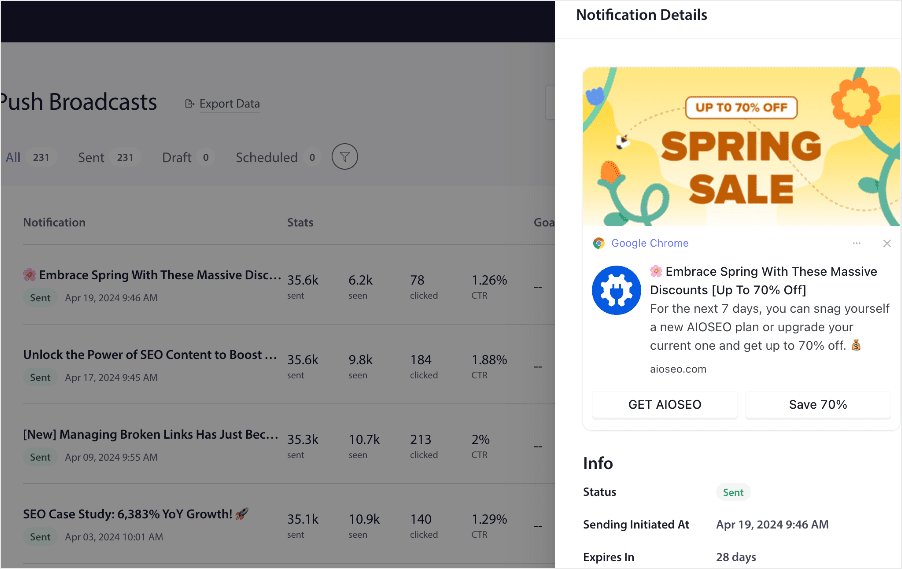
Some ways to use push notifications to boost your eCommerce SEO include:
- New product launches: Send push notifications to inform your audience about new product releases or restocks. Pro tip: use compelling visuals and product highlights. This can generate buzz and drive traffic to your eCommerce store.
- Product recommendations and upsells: Use push notifications to recommend or upsell complementary products based on a customer’s browsing history or purchase patterns. These personalized recommendations can significantly improve cross-selling and boost average order values (AOVs).
- Limited-time offers and promotions: Send push notifications about limited-time sales, flash deals, or exclusive promotions to create a sense of urgency and excitement. This can incentivize customers to take immediate action and make a purchase.
- Customer loyalty programs: Engage and reward your loyal customer base by sending push notifications about loyalty program updates, exclusive perks, or special events tailored specifically for them.
These are fantastic ways of encouraging engagement on your store. Plus, they also boost sales.
eCommerce SEO: Your FAQs Answered
What is the importance of eCommerce SEO?
eCommerce SEO is essential for driving organic traffic, enhancing user experience, and ultimately, boosting sales and revenue. By optimizing your eCommerce presence for search engines, you can gain a significant competitive advantage in the digital marketplace.
Does eCommerce need SEO?
Absolutely! SEO is crucial for any online store’s success in today’s digital age. It’s a cost-effective way to attract targeted traffic, improve brand awareness, and ultimately drive sales.
How do I optimize my eCommerce SEO?
Effective eCommerce SEO involves a combination of technical optimizations, on-page optimization, content creation, and off-page strategies. The tips outlined in this guide provide a solid foundation for improving your eCommerce SEO.
We hope this post has helped you discover some of the top eCommerce SEO strategies for driving more traffic and sales. You may also want to check out other articles on our blog, like our guide to common SEO mistakes to avoid or our article on the benefits of SEO for small businesses.
If you found this article helpful, then please subscribe to our YouTube Channel. You’ll find many more helpful tutorials there. You can also follow us on X (Twitter), LinkedIn, or Facebook to stay in the loop.
Disclosure: Our content is reader-supported. This means if you click on some of our links, then we may earn a commission. We only recommend products that we believe will add value to our readers.

![The Ultimate Guide to Ecommerce SEO [2024 Edition] 2 Image](https://aioseo.com/wp-content/uploads/2023/09/Image.png)
